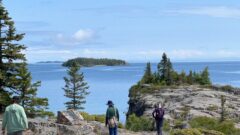How the Great Lakes region inspired the first Earth Day
Wisconsin Senator Gaylord Nelson, a student group at the University of Michigan, and the United Auto Workers union were among the main organizers to build momentum in organizing the first Earth Day in 1970. Read the full story by Great Lakes Now.
Great Lakes Commission
https://www.glc.org/dailynews/20250423-first-earth-day
Who can drink Great Lakes water? Joliet, Illinois, raises a familiar — and contentious — question
This year, Chicago breaks ground on a pipeline that will bring water from the Great Lakes to some suburbs whose groundwater is running dry. Read the full story by WBUR – Boston, MA.
Great Lakes Commission
https://www.glc.org/dailynews/20250423-drinking-water
Will offshore wind ever come to the Great Lakes?
Wind turbines in the Great Lakes have the potential to produce huge amounts of clean energy, but offshore wind has been banned by a moratorium in Ontario since 2011 and faces challenges in the U.S. Read the full story by CBC News.
Great Lakes Commission
https://www.glc.org/dailynews/20250423-offshore-wind
Environmental advocates oppose Ohio House plan to cut clean water program nearly 45%
Ohio House lawmakers voted this month to make steep cuts to the statewide water quality program, H2Ohio, which was formed after toxins left Toledo temporarily without safe drinking water. Read the full story by WYSO – Yellow Springs, OH.
Great Lakes Commission
https://www.glc.org/dailynews/20250423-ohio-cuts
Can these invasive reeds be stopped?
Invasive Phragmites are overwhelming Ontario’s wetlands, but a team of dedicated experts and community members are fighting back. Read the full story by Great Lakes Now.
Great Lakes Commission
https://www.glc.org/dailynews/20250423-phragmites
What to expect with the start of 2025’s fishing season
A new fishing season started this month, and that means Michigan’s Department of Natural Resources has plans for stocking sport fish in the state’s waters. Read the full story by Great Lakes Echo.
Great Lakes Commission
https://www.glc.org/dailynews/20250423-fishing-season
The environment is under attack. The Rights of Nature movement can save it
Last month, a bill was introduced in the New York State Assembly that would grant the Great Lakes and all other bodies of water in New York legal rights to exist “free from human violations.” This would allow the Great Lakes to be defended in court. Read the full story by Rolling Stone.
Great Lakes Commission
https://www.glc.org/dailynews/20250423-rights-of-nature
Great Lakes cruise, diverted by Detroit Grand Prix, to dock in Toledo
A cruise ship will visit Toledo, Ohio, next month for the first time since the late 1990s thanks to the efforts of local officials and an auto race that is diverting the ship from Detroit. Read the full story by The Toledo Blade.
Great Lakes Commission
https://www.glc.org/dailynews/20250423-cruise-toledo
Great Lakes freighters don’t take holidays. What Easter looked like on one
Mariners have a busy schedule to keep commerce flowing to the industrial and manufacturing centers in the region, but that doesn’t stop them from celebrating with food and festivities on board the vessels. Read the full story by MLive.
Great Lakes Commission
https://www.glc.org/dailynews/20250423-freighter-easter
COMMENTARY: How to photograph mysterious freshwater fish
Many of the shallow waterways of the Great Lakes have only been surveyed by researchers in waders using nets and traps. Very few have been explored by skilled underwater photographers, until recently. Read the full story by Great Lakes Now.
Great Lakes Commission
https://www.glc.org/dailynews/20250423-photographing-fish
More Fire, More Water
How the Great Lakes region inspired the first Earth Day

On the heels of the anti-war protests that were taking 1960s college campuses by storm, Wisconsin Sen. Gaylord Nelson was inspired to use that same momentum to create a protest so large that it would create an environmental movement.
An estimated 20 million Americans gathered on what would become known as Earth Day, with thousands of college campuses and high schools across the country engaged in the action.
Great Lakes Now
https://www.greatlakesnow.org/2025/04/how-great-lakes-region-inspired-the-first-earth-day/
Why Plants = A Healthier, Happier Lake Winnebago
If you fish it, boat it, live near it, or just plain love it—Lake Winnebago is part of your life. It’s a source of joy, pride, and countless summer memories. And believe it or not, one of the best things for this lake is something simple: plants. Yep—those weedy green patches that pop up [...]
The post Why Plants = A Healthier, Happier Lake Winnebago appeared first on Fox-Wolf Watershed Alliance.
Fox-Wolf Watershed Alliance
https://fwwa.org/2025/04/22/lake-winnebago-aquatic-plants-water-levels/?utm_source=rss&utm_medium=rss&utm_campaign=lake-winnebago-aquatic-plants-water-levels
Why Plants = A Healthier, Happier Lake Winnebago
If you fish it, boat it, live near it, or just plain love it—Lake Winnebago is part of your life. It’s a source of joy, pride, and countless summer memories. And believe it or not, one of the best things for this lake is something simple: plants. Yep—those weedy green patches that pop up [...]
The post Why Plants = A Healthier, Happier Lake Winnebago appeared first on Fox-Wolf Watershed Alliance.
Fox-Wolf Watershed Alliance
https://fwwa.org/2025/04/22/lake-winnebago-aquatic-plants-water-levels/?utm_source=rss&utm_medium=rss&utm_campaign=lake-winnebago-aquatic-plants-water-levels
Ph.D. student finds unique way to talk about aquatic invasive research
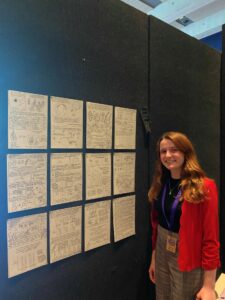 Water researchers are always looking for new and innovative ways to reach out to people about how the impacts of their work can help improve water quality. Serena George is one of those researchers.
Water researchers are always looking for new and innovative ways to reach out to people about how the impacts of their work can help improve water quality. Serena George is one of those researchers.
A Ph.D. student in veterinary medicine and molecular and environmental toxicology at the University of Wisconsin–Madison, Serena has created “Finding Norman,” a comic book story about a fish involved in Eurasian watermilfoil research, one of the more well-known and challenging aquatic invasive species inhabiting our waterways, including in the Great Lakes region. The project was inspired by her work with Sea Grant’s Emerging Contaminants Specialist Gavin Dehnert.
Readers can follow Norman on his journey through the scientific experimental process while learning about the importance of water research in helping control invasive species, which can harm native flora and fauna and impact our local economies.
Serena is shown sharing her strip at UW–Madison’s Spring Research Day, held last March. The project is supported by the Wisconsin Department of Natural Resources and the UW–Madison School of Veterinary Medicine.
The post Ph.D. student finds unique way to talk about aquatic invasive research first appeared on Wisconsin Sea Grant.
Blog | Wisconsin Sea Grant
https://www.seagrant.wisc.edu/blog/ph-d-student-finds-unique-way-to-talk-about-aquatic-invasive-research/
Can these invasive reeds be stopped?

Invasive phragmites are overwhelming Ontario’s wetlands, choking out native plants and wildlife. Towering up to 15 feet (5 meters) tall and spreading in dense clusters, this plant outcompetes native species, disrupts ecosystems, and threatens wildlife. But a team of dedicated experts and community members are fighting back.
Wetland ecologist Janice Gilbert is leading efforts at Kettle and Stony Point First Nation to combat phragmites.
Great Lakes Now
https://www.greatlakesnow.org/2025/04/can-these-invasive-reeds-be-stopped/
A Tough Update—But Our Work Isn’t Finished
A message from Fox-Wolf's Executive Director Fox-Wolf Friends, I want to be open with you about some challenging news. Recently, we learned that the USDA terminated two major Climate Smart grants we were managing. This decision wasn’t based on our effectiveness, results, or any kind of fiscal mismanagement or wrongdoing. Instead, it came [...]
The post A Tough Update—But Our Work Isn’t Finished appeared first on Fox-Wolf Watershed Alliance.
Fox-Wolf Watershed Alliance
https://fwwa.org/2025/04/22/climate-smart-grant-term/?utm_source=rss&utm_medium=rss&utm_campaign=climate-smart-grant-term
Plan Ahead: Know What to Do to Limit Invasive Plants this Spring
Original story: Melinda Myers Invasive plants can escape the boundaries of our landscape, moving into natural spaces and waterways. They outcompete and displace native plants, degrading natural habitats, increasing the risk of soil erosion, negatively impacting water quality, and so much more. Invasive plants, like this garlic mustard, outcompete and displace native plants, [...]
The post Plan Ahead: Know What to Do to Limit Invasive Plants this Spring appeared first on Fox-Wolf Watershed Alliance.
Fox-Wolf Watershed Alliance
https://fwwa.org/2025/04/21/plan-ahead-know-what-to-do-to-limit-invasive-plants-this-spring/?utm_source=rss&utm_medium=rss&utm_campaign=plan-ahead-know-what-to-do-to-limit-invasive-plants-this-spring
I Speak for the Fish: How to photograph mysterious freshwater fish

I Speak for the Fish is a monthly column written by Great Lakes Now Contributor Kathy Johnson, coming out the third Monday of each month. Publishing the author’s views and assertions does not represent endorsement by Great Lakes Now or Detroit Public Television.
Great Lakes Now
https://www.greatlakesnow.org/2025/04/i-speak-for-the-fish-how-to-photograph-mysterious-freshwater-fish/
5 Reasons Why Our Volunteers Are the Heart of the Alliance
It often starts the same way.
A pair of gloves. A trash receptacle. A stretch of shoreline that’s seen better days.
When our volunteers show up, something shifts.
They bring more than time. They bring intention. A quiet kind of leadership that doesn’t need a spotlight — just a reason. And for them, protecting the Great Lakes has always been reason enough.
At the Alliance for the Great Lakes, we believe lasting change is built by people who care deeply — and act consistently. This Volunteer Appreciation Week, we’re honored to celebrate those who show us what that looks like.
Here are five reasons why our volunteers aren’t just helpful — they’re the heartbeat of this work.
1. They Show Up and Show Out
In 2024, volunteers held 925 cleanups across all five Great Lakes and in all eight Great Lakes states. That’s more than just a strong turnout — that’s a region-wide demonstration of care. Together, they collected 573,608 pieces of litter — 42,000 more than the year before — and removed 23,560 pounds of litter from our shorelines. Our volunteers never fail to rise to the moment.
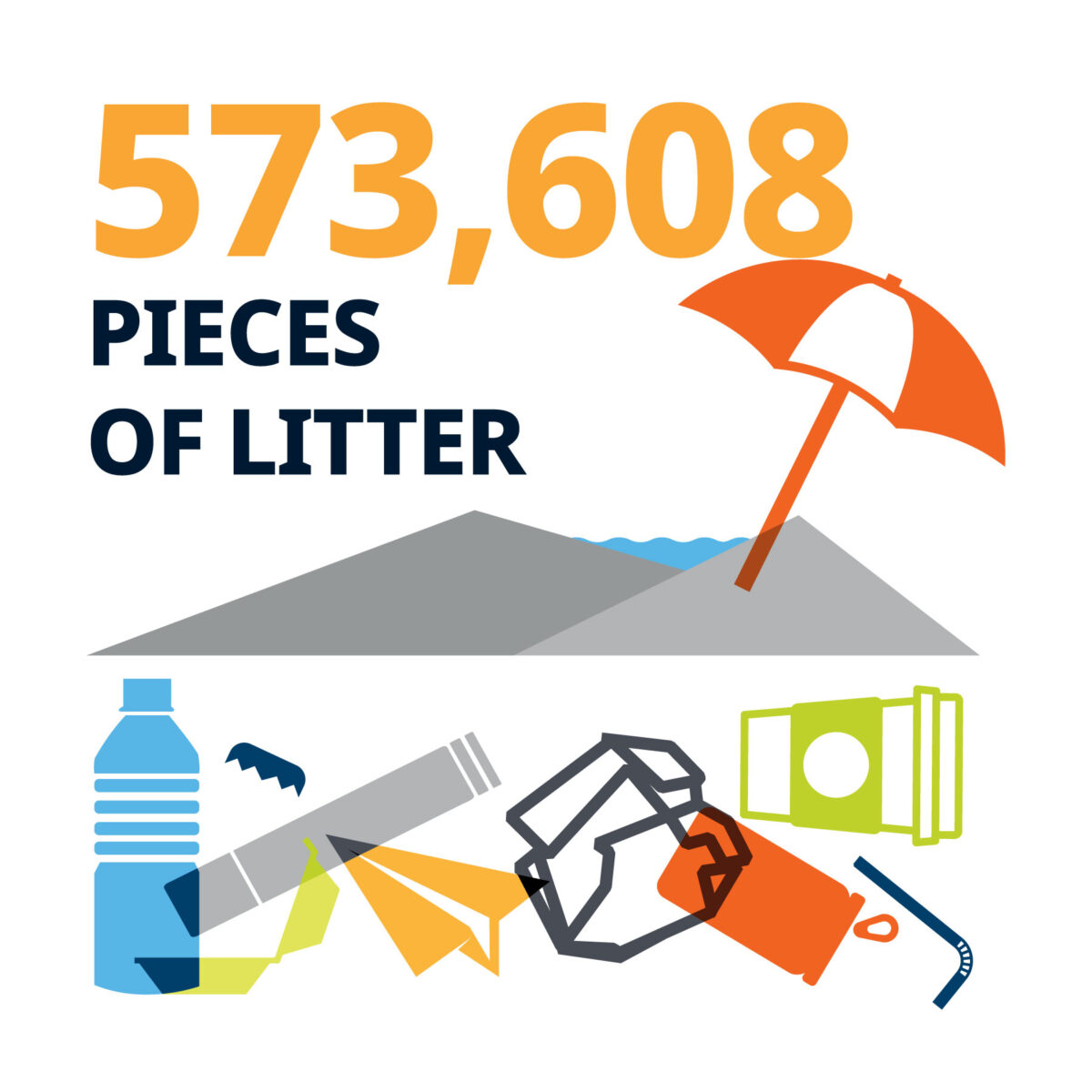
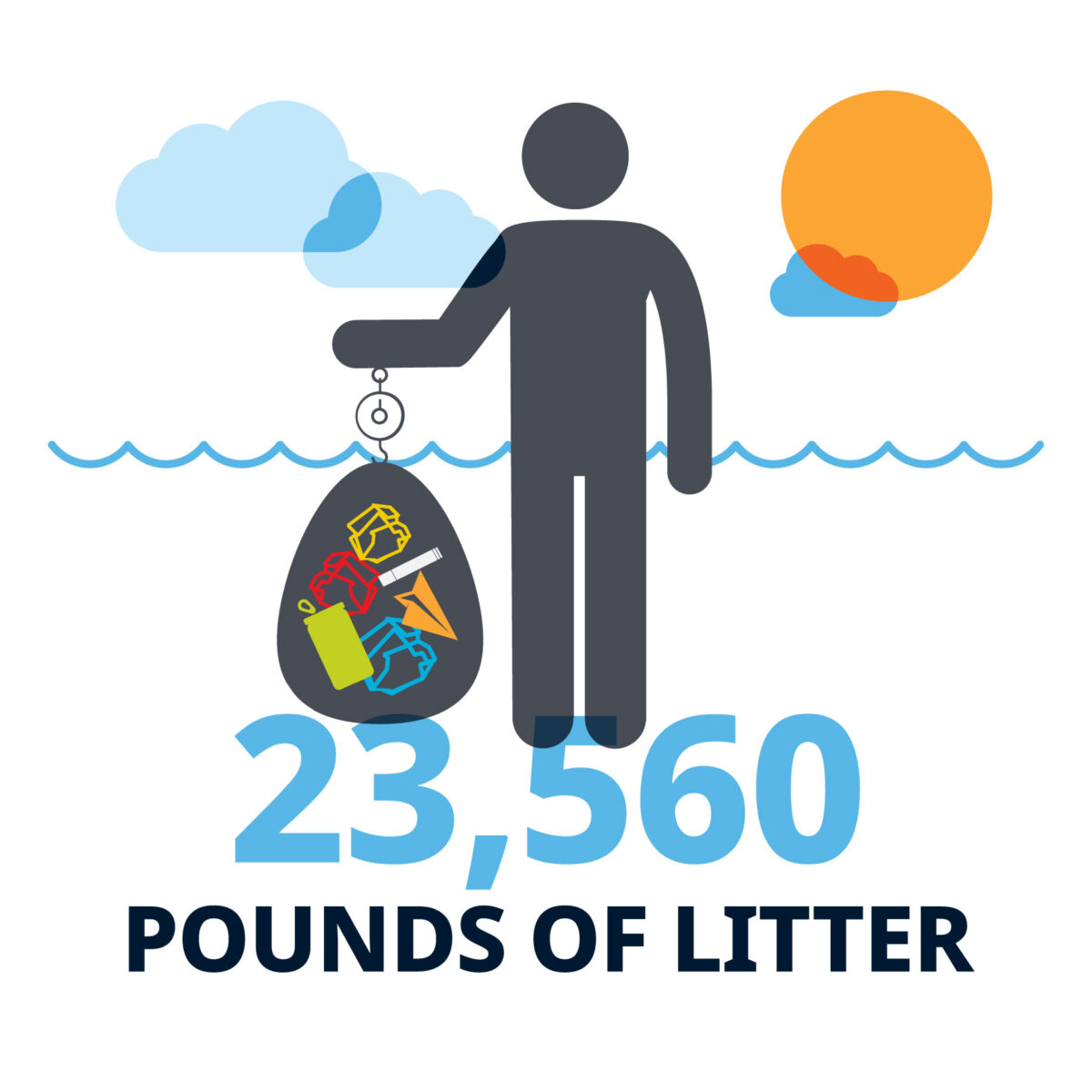
2. They Build a Record and Create a Voice for the Lakes
Every piece of litter collected — all 10 million and counting since 2003 — is logged into a growing community science database. It’s now one of the most comprehensive sources of data about Great Lakes litter available, used by researchers, advocates, and lawmakers alike. In 2024 alone, volunteers contributed 28,312 hours and participated in 11,342 volunteer experiences — both up from the year before. That’s not just data — that’s dedication.
3. They Create a Ripple Effect Across Communities
From longtime volunteers to first-timers, we see the same energy: hopeful, steady, and committed.
As Annie P. from Illinois said:
“Lake Michigan changes every day except in its unwavering beauty. Thank you to every volunteer for all the work you do on behalf of all the Great Lakes.”
This work inspires. One cleanup can turn into a family tradition. One data point can shape policy. One act of care can reach across neighborhoods and generations.
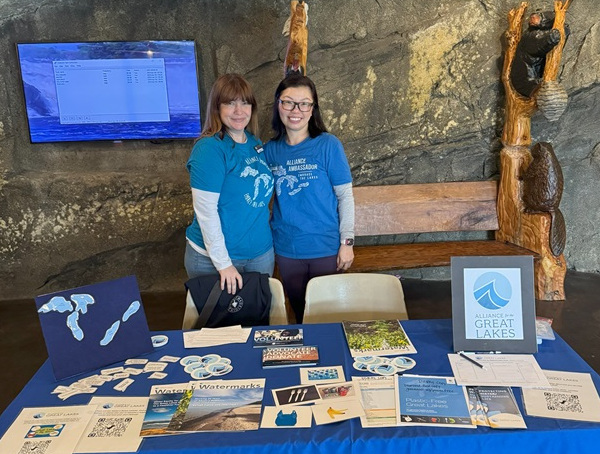
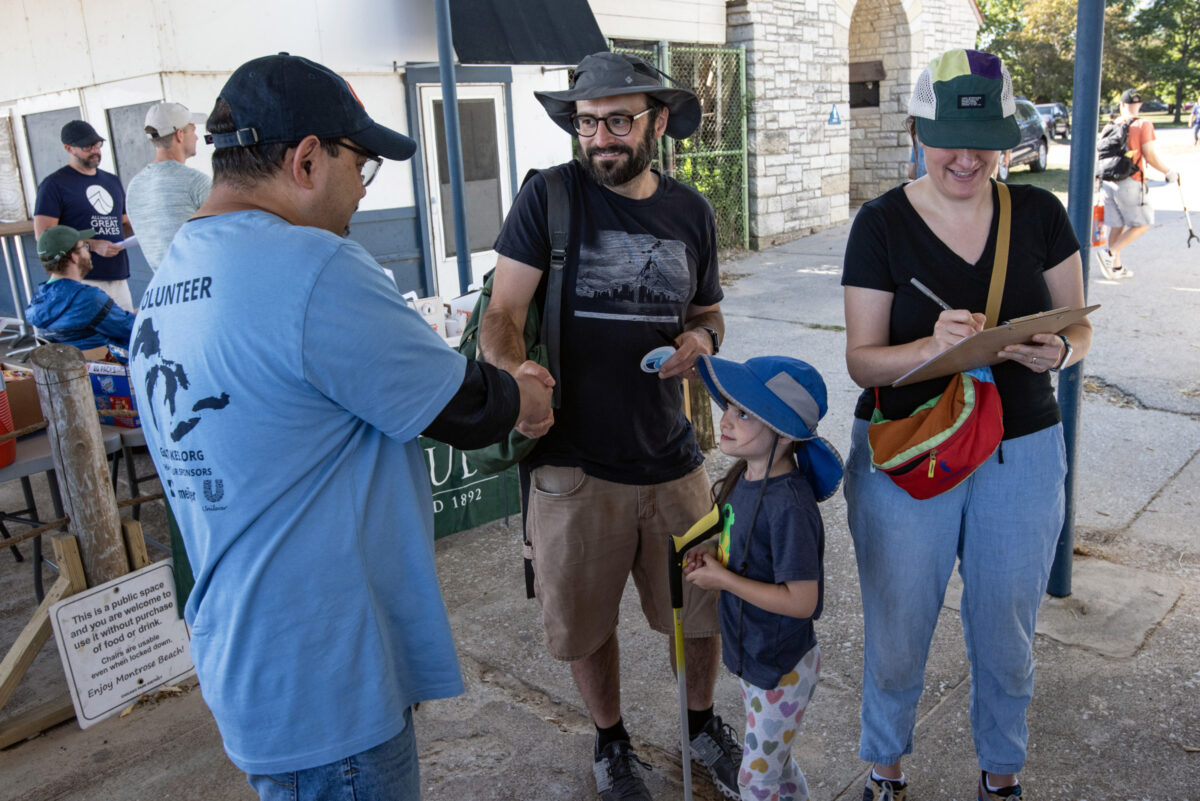

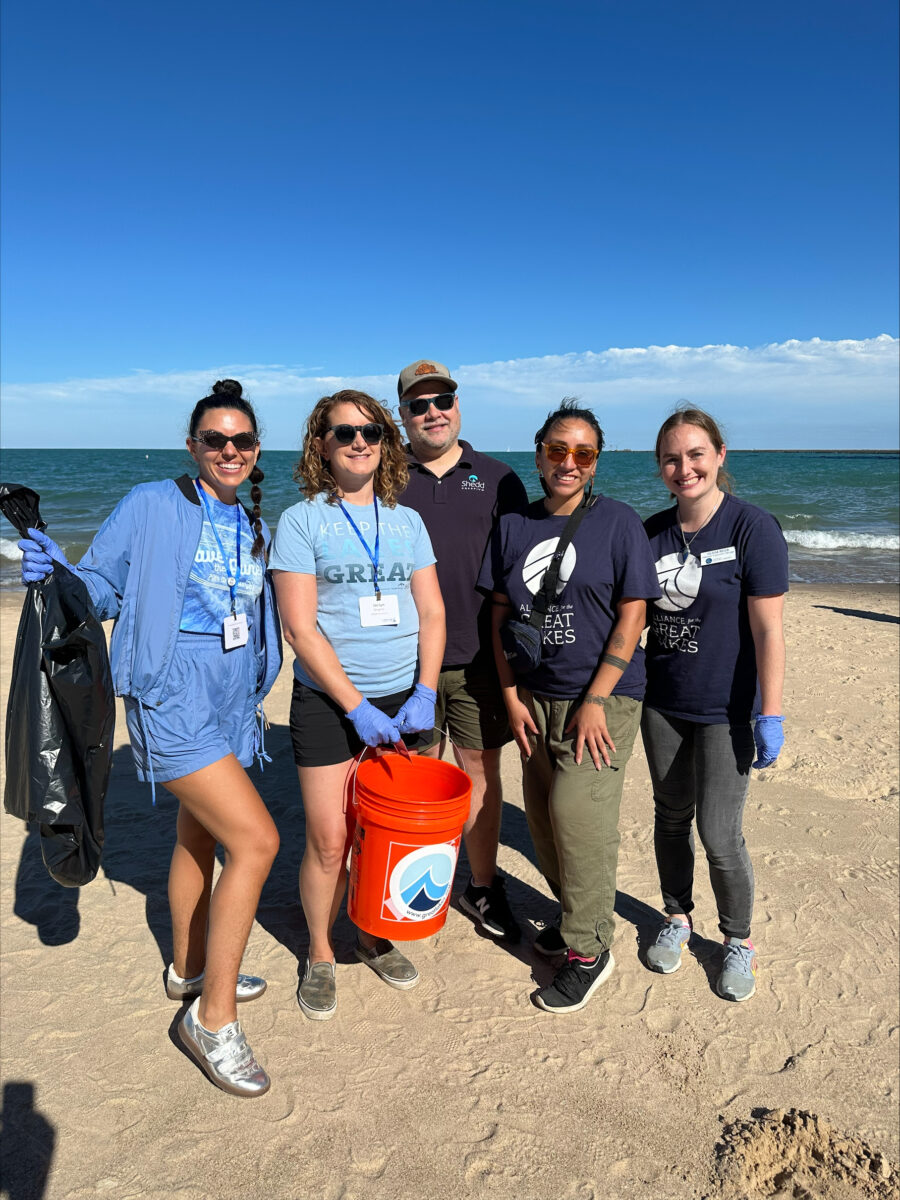
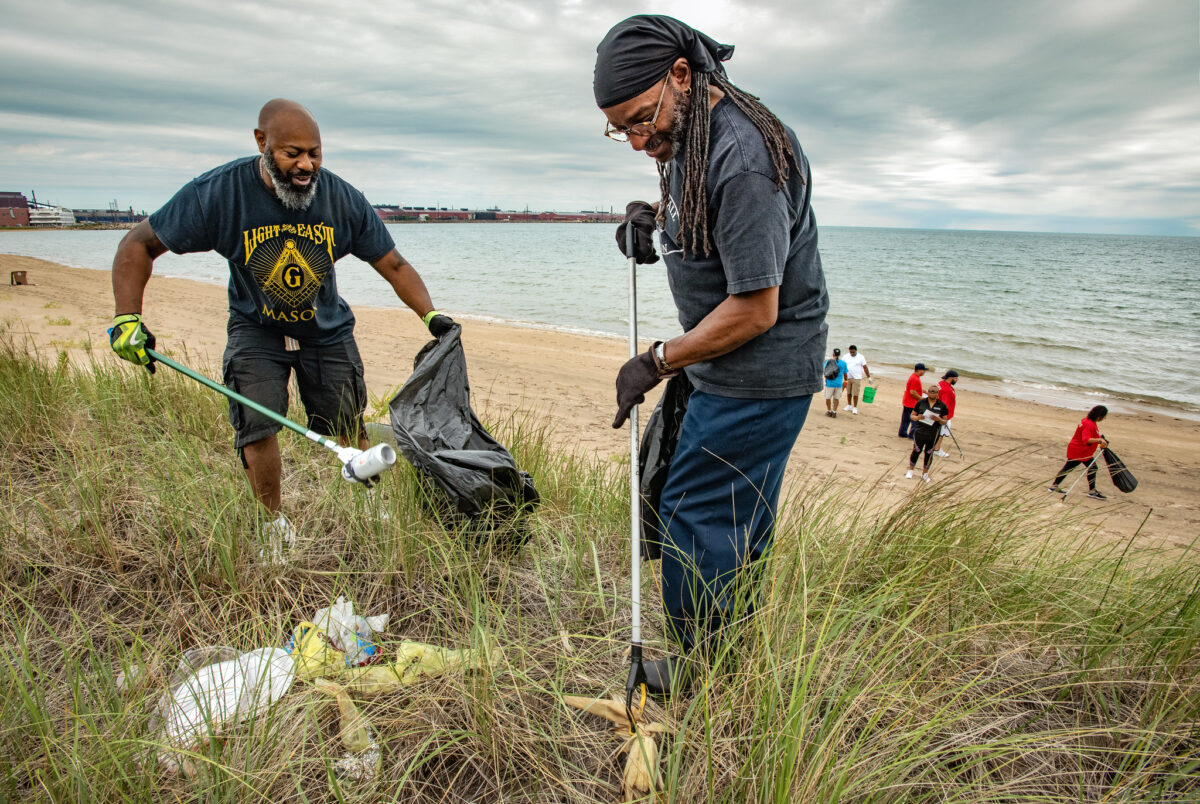
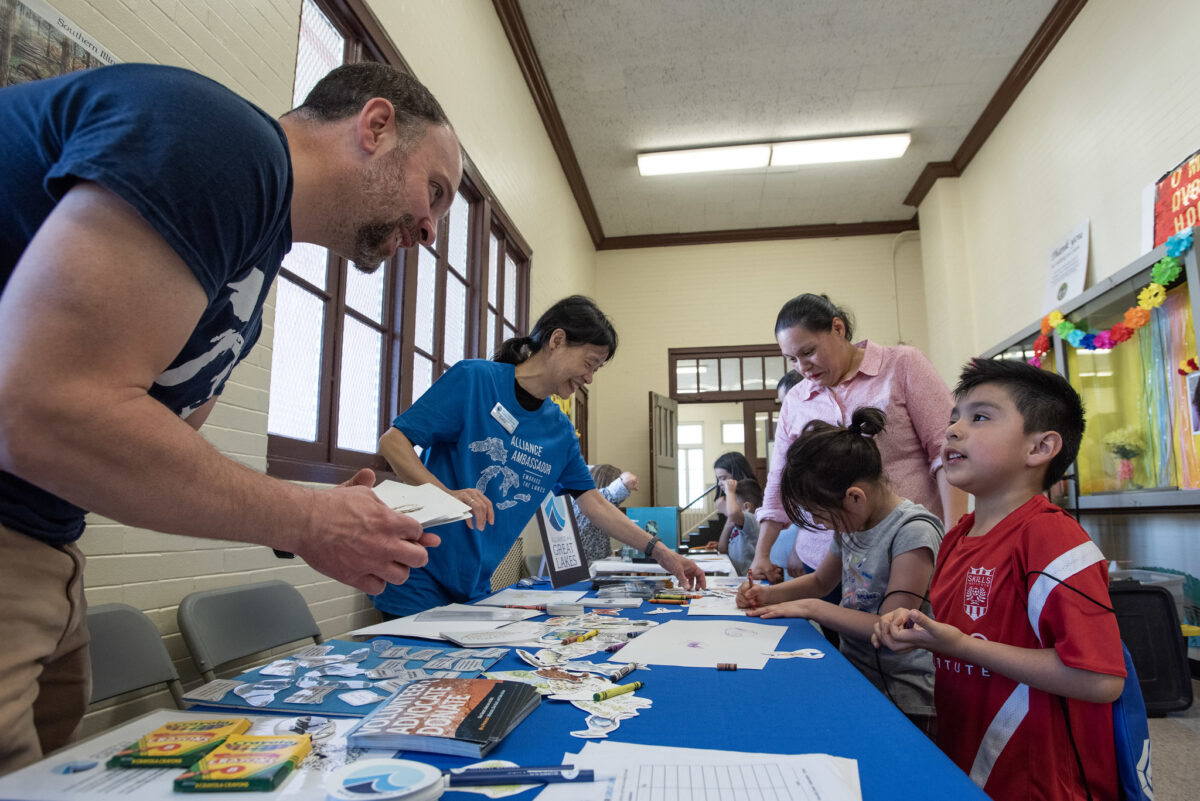
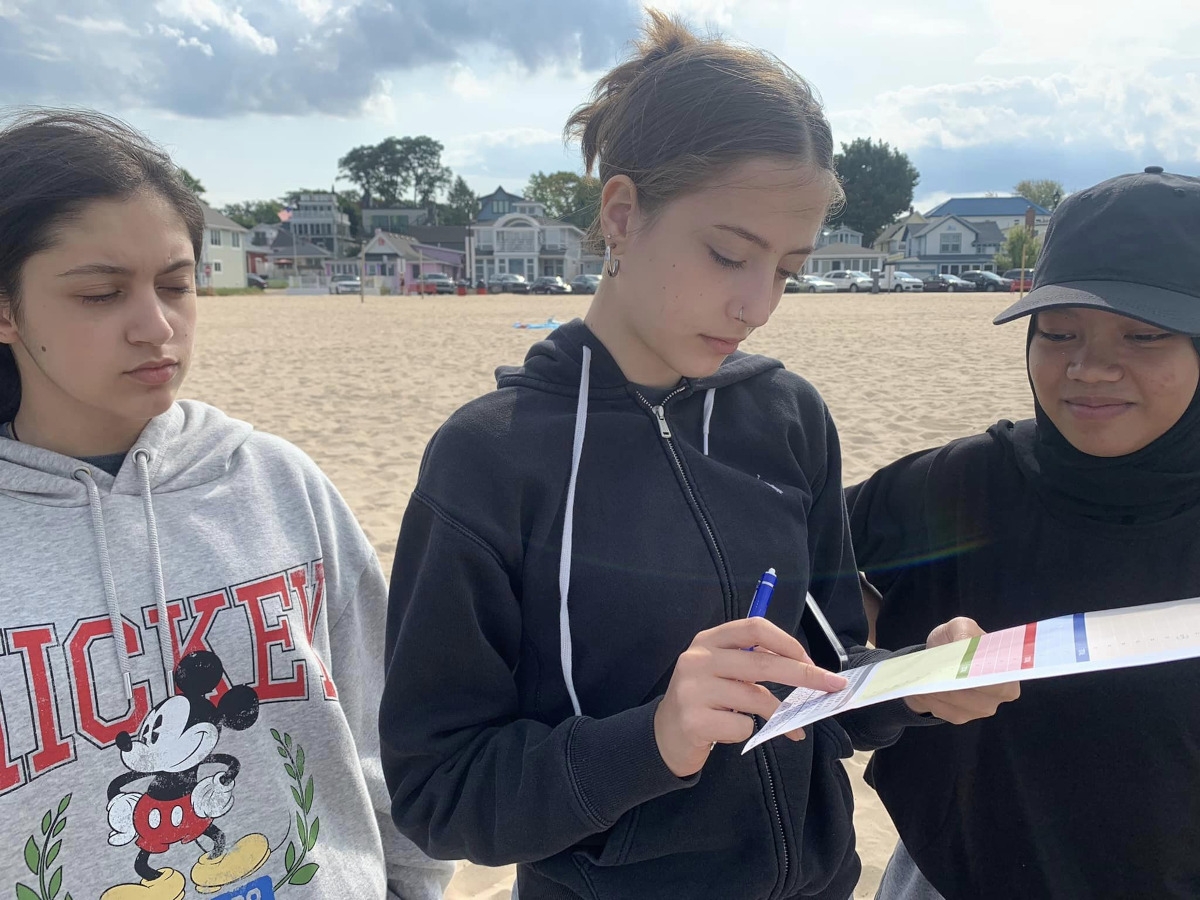

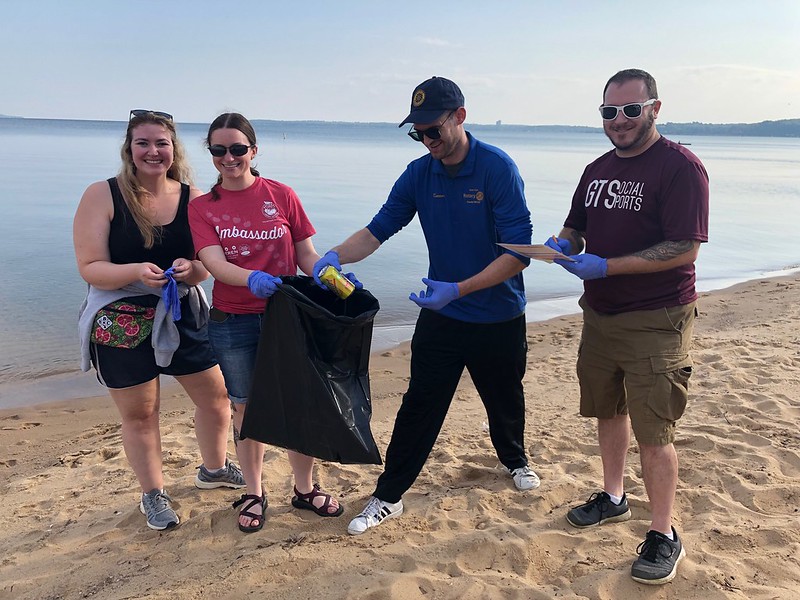
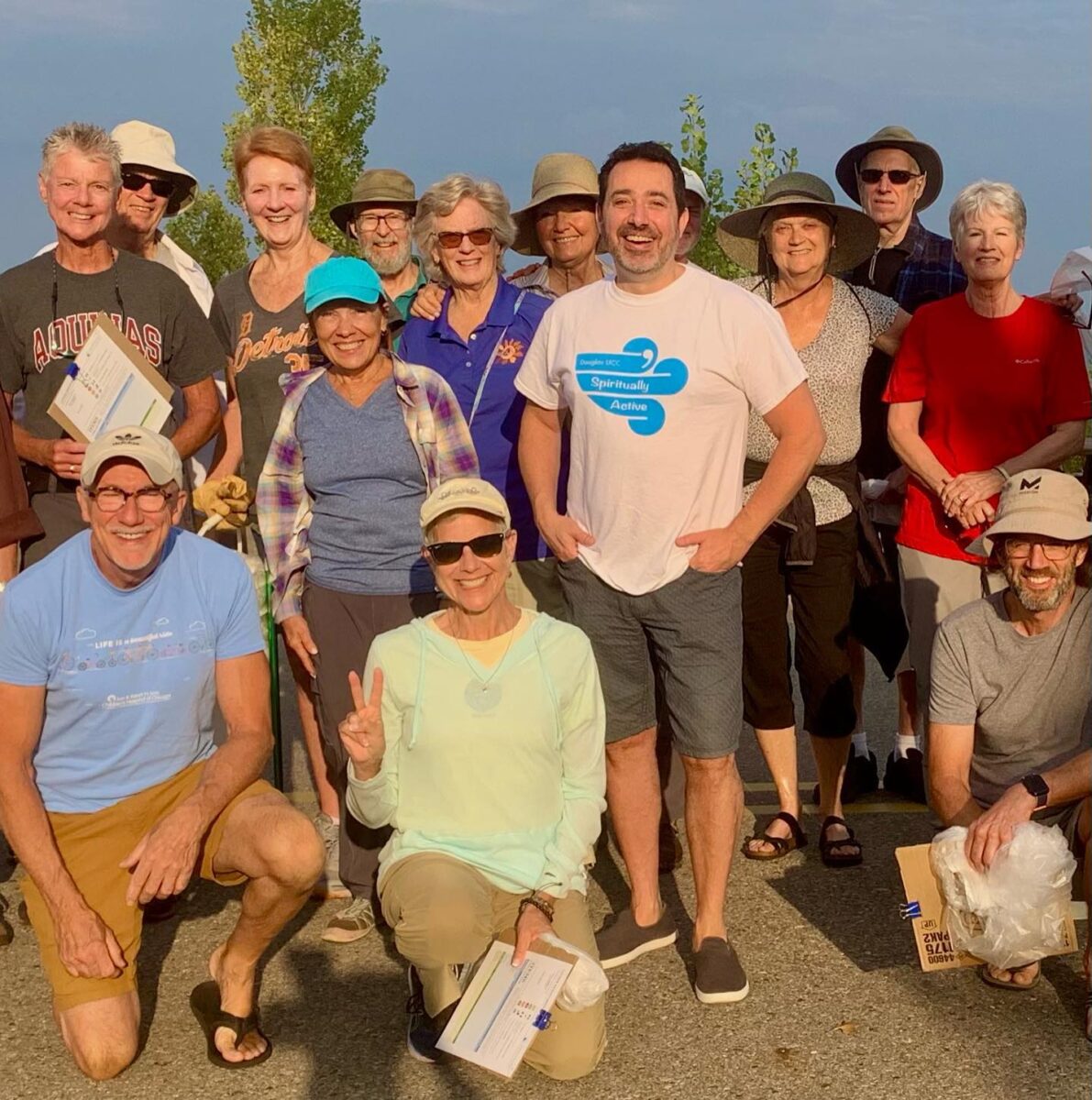

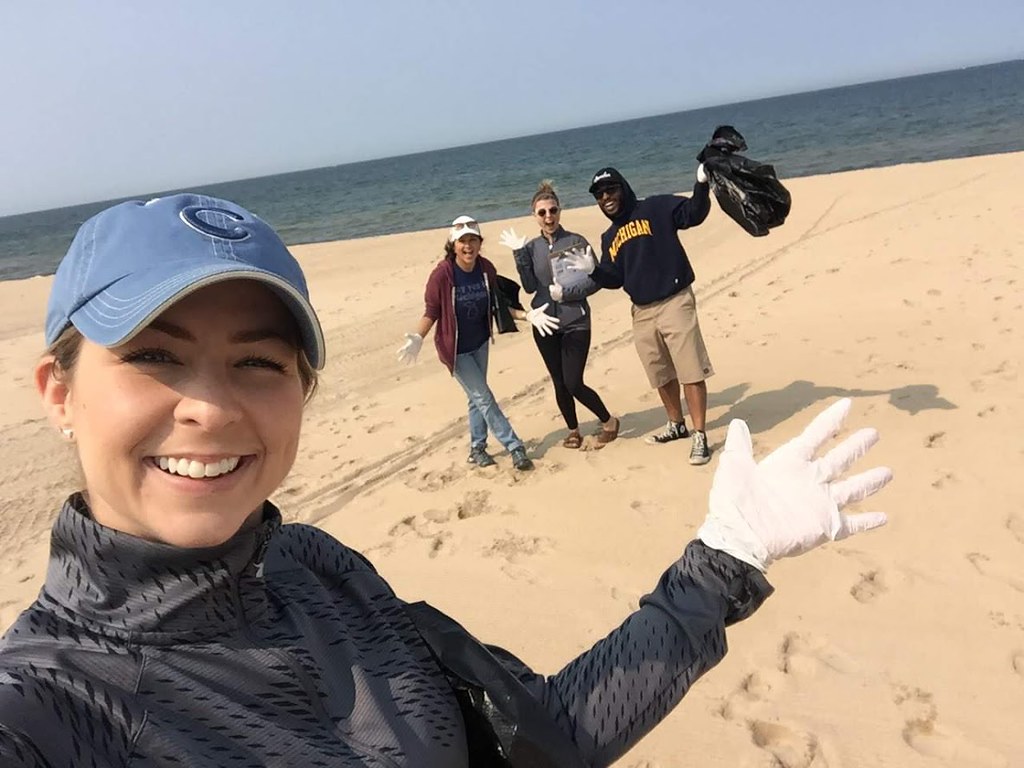
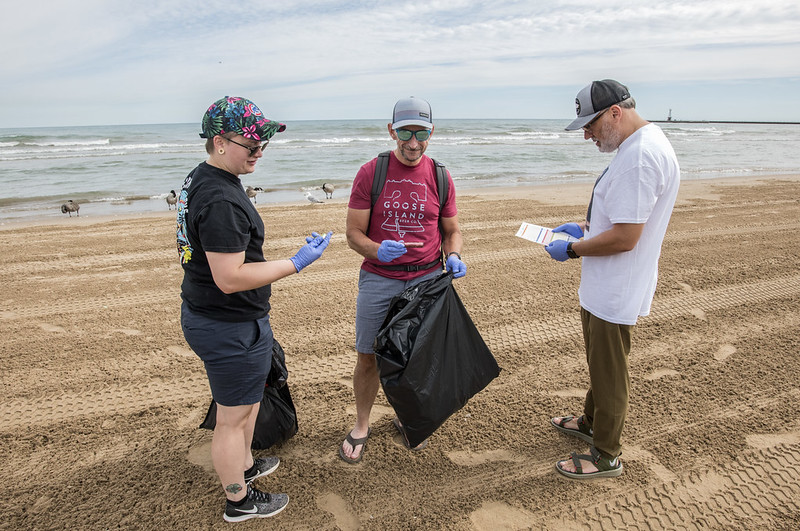
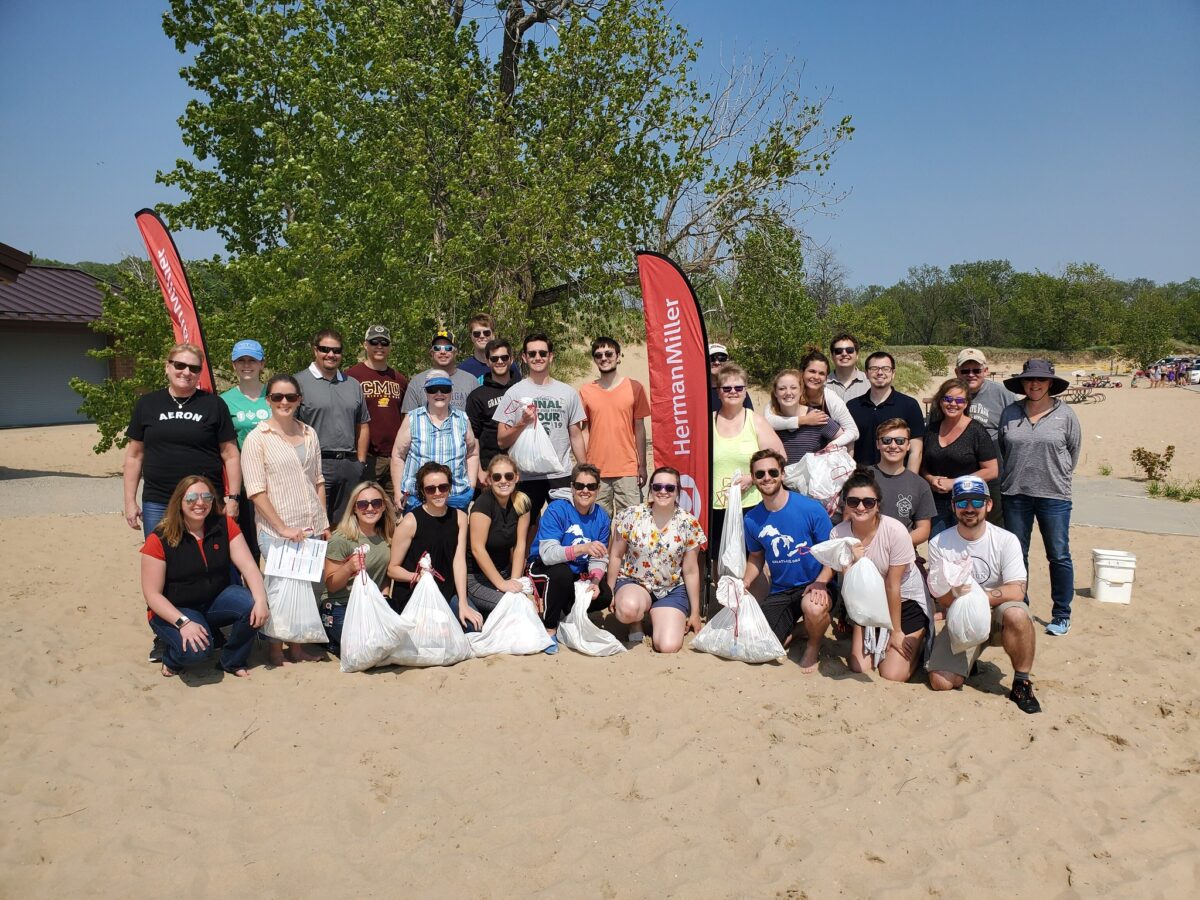
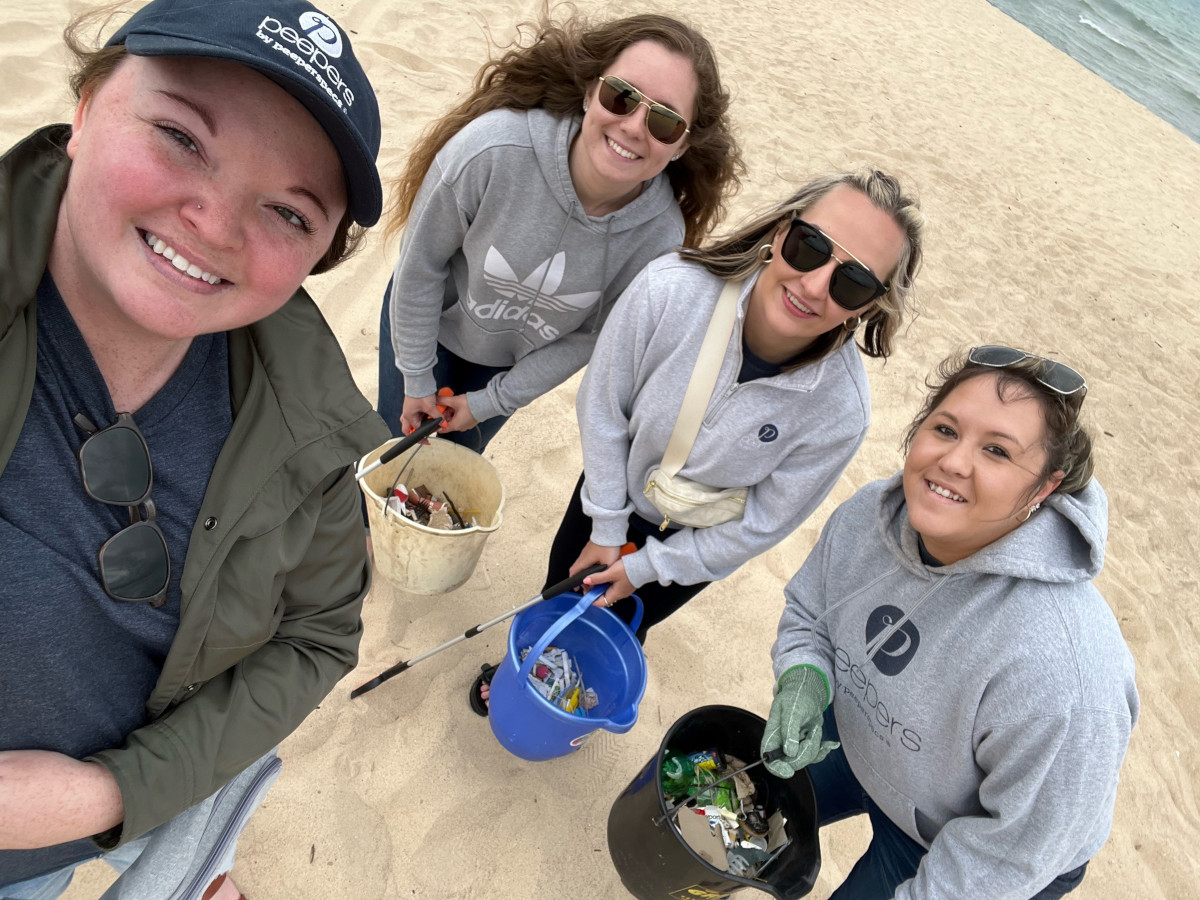
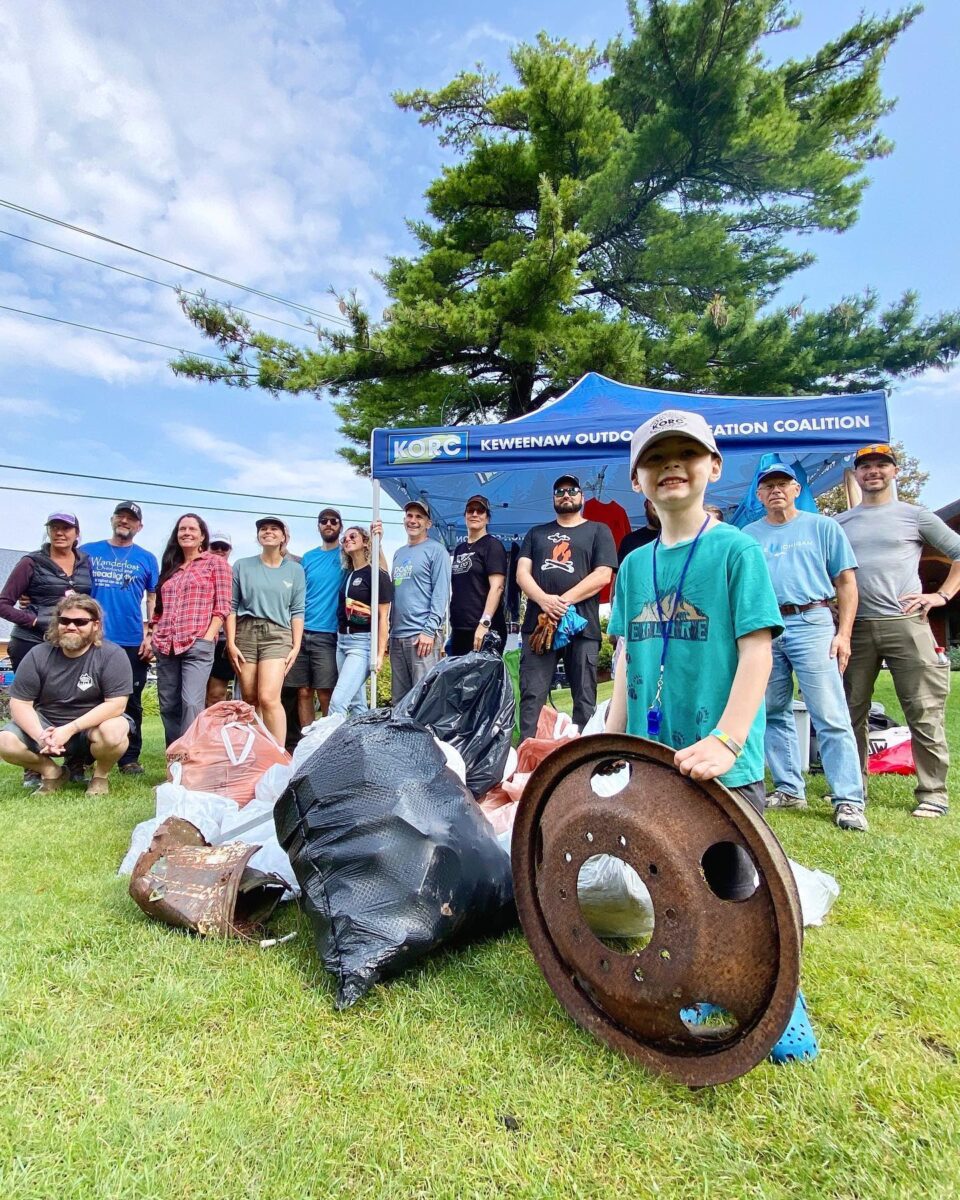
4. They Help Turn Data into Action
The work our volunteers do has helped push forward policy change — like Illinois’ recent ban on single-use plastic toiletry bottles in hotels and growing efforts to reduce plastic waste.
And our volunteers reach out to their elected officials – at the state and federal level – by the thousands. They send messages in support of policies that protect the lakes from invasive species, plastic pollution, toxic algal blooms, and more.
Because of their data, their dedication, and their stories — lawmakers are listening. This is how grassroots action becomes real-world results. Our volunteers help carry that momentum forward.
5. Our Ambassadors Expand our Reach and Share our Message Our Alliance Ambassadors spread love for the lakes and awareness of the lakes across the entire Great Lakes region. They build community and allow the Alliance to have a larger and deeper reach. By meeting with people in school groups, local civic organizations, faith groups and more, they show how we’re all connected by the water we share.
To every Alliance volunteer — thank you.
As Mary E. from Ontario wrote so thoughtfully:
“You keep this beloved area safe… a refuge and a home for people and creatures of all kinds.”
Your efforts reflect something bigger than a cleanup. They reflect a commitment to legacy — to passing on a cleaner, safer Great Lakes region to future generations.
Thank you for your time, your energy, and your steady presence.
You show us what it looks like to protect what we love. And because of you, the Great Lakes truly are in great hands.
The post 5 Reasons Why Our Volunteers Are the Heart of the Alliance appeared first on Alliance for the Great Lakes.
News - Alliance for the Great Lakes
News - Alliance for the Great Lakes
https://greatlakes.org/2025/04/5-reasons-why-our-volunteers-are-the-heart-of-the-alliance/
Ways to celebrate Earth Day this year
In Alpena, Michigan, the non-profit organization, Great Lakes Great Responsibility, is hosting two events to celebrate Earth Day by clearing trash and cleaning storm drains to protect Lake Huron. Read the full story by the Alpena News.
Great Lakes Commission
https://www.glc.org/dailynews/20250421-earth-day-2025
US Army engineers decide to fast-track Great Lakes tunnel permits under Trump energy emergency order
The U.S. Army Corps of Engineers has decided to fast-track permits for building a protective tunnel around an aging Enbridge oil pipeline that runs beneath a channel connecting two Great Lakes. Read the full story by KFIZ – Fond du Lac, WI.
Great Lakes Commission
https://www.glc.org/dailynews/20250421-protective-tunnel
First saltie that transited the whole Seaway arrives in Duluth on Monday morning
The Federal Nagara was the first ocean-going vessel to transit the full St. Lawrence Seaway originating from Germany and stopping in Contrecoeur, Quebec, before continuing to Duluth, Minnesota. Read the full story by the WDIO-TV – Duluth, MN.
Great Lakes Commission
https://www.glc.org/dailynews/20250421-first-saltie
Severe cuts at NOAA would kill Great Lakes data buoy network
The Great Lakes Observing System is facing potential shutdown of its real-time data network of buoys and meteorological towers under a fiscal 2026 Trump administration budget proposal that cuts roughly $1.6 billion from NOAA. Read the full story by MLive.
Great Lakes Commission
https://www.glc.org/dailynews/20250421-glos-bouys
Shared waters: U.S.-Canada tensions raise concerns over Great Lakes stewardship
Trump administration tariffs and diplomatic fallout may jeopardize joint conservation programs protecting North America’s largest freshwater system. Read the full story by The Badger Herald.
Great Lakes Commission
https://www.glc.org/dailynews/20250421-tariff-impacts
Why so many dead fish are washing ashore of Lake Erie
Millions of alewife died over the winter and are now washing ashore. Fear not, however, as the die-off can be seen as Mother Nature’s way of keeping checks. Read the full story by the Buffalo News.
Great Lakes Commission
https://www.glc.org/dailynews/20250421-erie-fish-kill
Dredging at Lake Michigan harbor scheduled to begin Thursday
The U.S. Army Corps of Engineers Detroit District will soon start dredging the entrance to Holland Harbor in Michigan to remove shoaling across the federal channel. Read the full story by MLive.
Great Lakes Commission
https://www.glc.org/dailynews/20250421-lake-michigan-dredging
Eastern Ontario Wardens’ Caucus signs partnership agreement with U.S.-Canada Great Lakes coalition
The recent signing of an agreement between elected officials along the Great Lakes and St. Lawrence River is a key step toward highlighting the importance of building community relationships across Canada and the U.S. Read the full story by kawarthaNOW.
Great Lakes Commission
https://www.glc.org/dailynews/20250421-us-canada-partnership
Lake Michigan falls below long-term average level
The U.S. Army Corps of Engineers says Lake Michigan is down 41-inches from its highest April level that was hit in 2020 and is now down seven-inches from last year. Read the full story by WGHN – Grand Haven, MI.
Great Lakes Commission
https://www.glc.org/dailynews/20250421-low-lake-levels
Smoke plumes from Ontario fires visible in Metro Detroit
Smoke plumes visible in Metro Detroit likely emanated from a marsh fire across Lake St. Clair on Squirrel Island in Ontario, Canada. Read the full story by the Detroit News.
Great Lakes Commission
https://www.glc.org/dailynews/20250421-smoke-plumes
Waves of Change: Meet artist, mom and gardener Halima Afi Cassells

Waves of Change is an online interview series highlighting the diverse faces and perspectives shaping the environmental justice movement throughout the Great Lakes region.
For Earth Month, we spoke with Halima Afi Cassells, an award-winning interdisciplinary community-engaged artist, mom of three and avid gardener with deep roots in Waawiiyaataanong also known as Detroit, Michigan.
Great Lakes Now
https://www.greatlakesnow.org/2025/04/waves-of-change-meet-artist-mom-and-gardener-halima-afi-cassells/
Cruising the Great Lakes: Victory Cruise Lines relaunching; plans U.S., Canada sailings
Victory Cruise Lines is relaunching in April with Great Lakes and Canada cruises. Those include All 5 Great Lakes cruises, which visit Erie, Huron, Michigan, Ontario and Superior, sailing from either Chicago or Milwaukee to Toronto. Read the full story by The Sault News.
Great Lakes Commission
https://www.glc.org/dailynews/20250418-cruisinggreatlakes-victorycruiselines
Great Lakes maritime industry gets backing from Trump Administration
The White House Executive Order issued April 9, called “Restoring America’s Maritime Dominance,” directs the Secretary of Commerce, in coordination with other cabinet members, to find opportunities to encourage investments in American “maritime prosperity zones”. Read the full story by the Morning Journal.
Great Lakes Commission
https://www.glc.org/dailynews/20250418-greatlakes-maritime-trump
Lab that helps forecast severe weather in Michigan ‘crippled’ by Trump staffing cuts
Essential functions at the federal Great Lakes research lab that monitors toxic algae blooms and helps forecast Michigan weather have been “crippled” by the Trump administration’s wave of federal firings. Read the full story by MLive.
Great Lakes Commission
https://www.glc.org/dailynews/20250418-lab-forecast-weather-michigan-trump
Rock hunter rescued after sand nearly swallows him on northern Michigan beach
Firefighters rescued a northern Michigan man on April 12 after he sank up to his waist in sand on the shore of Lake Michigan near Leland while rock hunting with his girlfriend. Read the full story by the Lansing State Journal.
Great Lakes Commission
https://www.glc.org/dailynews/20250418-rock-hunter-michigan
New designation will protect Indiana’s Lake Michigan shipwrecks
A new designation, if approved, will provide “special protection in perpetuity” to Indiana’s Lake Michigan shipwrecks by designating them as “submerged land preserves.” Read the full story by Northwest Indiana Times.
Great Lakes Commission
https://www.glc.org/dailynews/20250418-indiana-lake-michigan-shipwrecks
Health department issues new warning about eating fish from some Minnesota lakes with ‘forever chemicals’
The Minnesota Department of Health has updated its advice on how much fish is safe to eat from certain lakes with so-called “forever chemicals.” The changes to the fish consumption guidelines affect about 44 water bodies in 10 counties, in both the Twin Cities and greater Minnesota. Read the full story by MPR News.
Great Lakes Commission
https://www.glc.org/dailynews/20250418-health-dept-minnesota
From algae to clarity: How the Shivering Sands/Dunes Lake Watershed was restored
Fed by creeks and springs that gurgle from the dolomite bedrock underlying the peninsula, three hidden, undeveloped lakes – Dunes, Arbiter and Schwartz – lie in the silhouette of these shivering sands. Nestled within a mile of the cliffs, caves and forested dunes of Lake Michigan, the lakes were choked by phosphorus-rich blankets of algae – victims of fortified agricultural, sanitary and septic system runoff. Read the full story by Door County Pulse.
Great Lakes Commission
https://www.glc.org/dailynews/20250418-algae-to-clarity
Early Season Invasive Plants To Watch For On Your Spring Walks
Spring Is a Great Time to Thaw Out - And Be On the Lookout Spring is a favorite time for many Wisconsinites. Everyday something new sprouts through the ground, blooms appear, and leaves begin filling empty branches. As you enjoy spring and summer unfolding, keep a lookout for unwelcome plants in gardens, waterways, and [...]
The post Early Season Invasive Plants To Watch For On Your Spring Walks appeared first on Fox-Wolf Watershed Alliance.
Fox-Wolf Watershed Alliance
https://fwwa.org/2025/04/18/early-season-invasive-plants-to-watch-for-on-your-spring-walks/?utm_source=rss&utm_medium=rss&utm_campaign=early-season-invasive-plants-to-watch-for-on-your-spring-walks
Wisconsin sees record start to the fire season as climate change drives more blazes
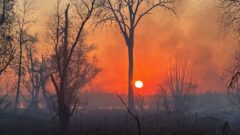
By Danielle Kaeding, Wisconsin Public Radio
This article was republished here with permission from Wisconsin Public Radio.
Wisconsin saw a record number of fires in January and February this year due to a lack of snow as climate change has set the stage for more wildfires.
Great Lakes Now
https://www.greatlakesnow.org/2025/04/wisconsin-wildfires-record-climate-change-drought/
Army Corps to fast track review of Line 5 tunnel project
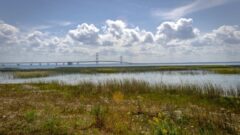
By Izzy Ross, Interlochen Public Radio
This coverage is made possible through a partnership between Interlochen Public Radio and Grist, a nonprofit environmental media organization.
The federal review of the Line 5 tunnel project will be sped up under new emergency permitting procedures announced by the Army Corps of Engineers this week.
Great Lakes Now
https://www.greatlakesnow.org/2025/04/army-corps-to-fast-track-review-of-line-5-tunnel-project/
Northeast Ohio surf shop owner making waves with boards made from used foam
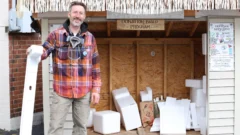
By Zaria Johnson, Ideastream Public Media
This story was originally published by Ideastream.
Expanded polystyrene foam is typically used in everything from packaging for new TVs to carry-out food containers, but Jeffrey McNaught, owner of Edgewater Surf in Rocky River, found an eco-friendly use for something that usually ends up in landfills.
Great Lakes Now
https://www.greatlakesnow.org/2025/04/northeast-ohio-surf-shop-owner-making-waves-with-boards-made-from-used-foam/
Wisconsinites voted for Clean Water Now: what’s next?
Wisconsinites voted for Clean Water Now: what’s next?
This month, Democratic legislators, Representative Darrin Madison, Senator Mark Spreitzer, and Senator Jodi Habush Sinykin, have reintroduced a Green Amendment to the state constitution. The move would formalize peoples’ rights to a clean, safe, and healthy environment.
Here’s how the amendment would read:
SECTION 1. Section 27 of article I of the constitution is created to read: [Article I] Section 27 The people, including future generations, have the right to a clean, safe, and healthy natural environment, including clean water, clean air, healthy soils, self-sustaining ecosystems, and a safe and stable climate, and to the preservation of the natural, cultural, and healthful qualities of the environment. These rights shall never be infringed, shall be subject to strict scrutiny review in court, shall be protected equitably for all communities in the state, and are self- executing.
(2) The state, as trustee, shall protect Wisconsin’s natural resources for all of the people of this state, including future generations.
There is deep gridlock at the state capitol and the state legislature’s resistance to making progress on the systemic changes we need to fully protect our drinking water, rivers, and lakes from pollution has been a barrier to our rights to clean water protection. The Green Amendment is a sign that we need some path forwards to meaningfully address critical water issues in Wisconsin.
Here’s how the Wisconsin state constitution is amended
The state legislature must pass the proposed change in two separate sessions. After that, the amendment goes to a statewide vote. If a majority of voters approve it, the constitution is officially changed. If not, it fails.
Wisconsinites have already voted for clean water
The good news is that many voters in Wisconsin have already voted for their desire for the state government to recognize their rights to a clean environment. Clean Water Now referendums in 2021 and 2022 showed strong, nonpartisan success when voters were directly asked on their ballots how much they care about Wisconsin’s water.
The question was simple: Should the State of Wisconsin establish a right to clean water to protect human health, the environment, and the diverse cultural and natural heritage of Wisconsin?
Here’s what happened:
In the spring of 2021, voters in Marquette County (73%), Portage County (77%) and Wood County (76%) approved referendums.
In the spring of 2022, voters in Eau Claire County (79%) and La Crosse County (86%) approved referendums.
In the fall of 2022, voters in Adams (79.7%), Bayfield (80%), Green (84%), Juneau (79.6%), and Outagamie (79.5%) Counties approved referendums.
Local governments have stepped up to pass resolutions too. Monroe County was the first to pass a Clean Water Now resolution on March 22, 2022 (PDF). Ashland County approved an inspiring resolution in support of clean water on October 9, 2023 (JPG) and Marinette County passed a resolution on December 19, 2023 (PDF).
When voters are asked if they believe in the right to clean water, they vote YES in strong numbers that transcend political party lines.
However, through a bad deal with Governor Evers over shared revenue funding, state legislators took away citizens’ rights to add advisory referendums to local ballots. Though state leaders took away our right to voice our opinions directly on our ballots, they can’t deny the overwhelming, nonpartisan success of the Clean Water Now referendums or our basic right to clean water. The Green Amendment could be another way of letting voters express how important the right to a clean environment is to us.
Wisconsinites can protect water now
The people of Wisconsin don’t have to wait for the passage of a Green Amendment to make progress on protecting Wisconsin’s clean water and heritage of our beloved natural spaces. Our next state budget has several key issues legislators can support for the health of people and our environment.
We can do something about PFAS pollution
The Joint Finance Committee has the power to release $125 million in funds to help families who can’t drink their water due to PFAS contamination. Those funds that were already approved in the last state budget are being withheld due to partisan political conflicts. The Governor’s proposed budget includes the $125 million and an additional $18.6 million for the DNR to support PFAS monitoring and remediation across Wisconsin. PFAS is truly a statewide problem that impacts people’s drinking water in big cities and small towns alike.
We can do something about lead pipes
The proposed state budget includes two critical investments that will support much-needed drinking water, wastewater, and stormwater infrastructure across Wisconsin. First, there is a proposed $200 million to support lead service line replacement through the DNR’s Safe Drinking Water Loan program. There is also a proposed $725.9 million in revenue bonds that will fund state match requirements and expand loan opportunities through the Drinking Water Loan Program and the Clean Water Fund Program.
We can do something about stewardship of land and water
Legislators also have the power to renew and fund the Knowles-Nelson Stewardship Program which is wildly popular across the political spectrum of voters. Those funds do everything from park maintenance and installing accessible fishing docks, to putting forests and riverfront property into conservation protection agreements so future generations can enjoy green spaces.
While we wait for a Green Amendment, we need legislators to take action today to protect our drinking water and respect what voters have already called for.
This message is made possible by generous donors who believe people have the power to protect and restore water. Subscribe to our Word on the Stream email newsletter to receive stories, action alerts and event invitations in your inbox. Support our work with your contribution today.
The post Wisconsinites voted for Clean Water Now: what’s next? appeared first on River Alliance of WI.
Blog - River Alliance of WI
https://wisconsinrivers.org/green-amendment-reintroduced/
In Indiana, natural gas is clean energy now

Catch the latest energy news from around the Great Lakes region. Check back for these biweekly Energy News Roundups.
Indiana now defines natural gas and propane as clean energy under a law signed by Gov.
Great Lakes Now
https://www.greatlakesnow.org/2025/04/in-indiana-natural-gas-is-clean-energy-now/
No Mow May or Low-Mow Lawn? Here’s What to Know Before You Stash the Mower
No Mow May is trending again—but is it actually the best move for your lawn and your water? It’s a tempting idea—skip mowing for a month to help bees and early-season pollinators. And yes, it can make a difference. But before you park the mower for May, let’s talk about what really works best [...]
The post No Mow May or Low-Mow Lawn? Here’s What to Know Before You Stash the Mower appeared first on Fox-Wolf Watershed Alliance.
Fox-Wolf Watershed Alliance
https://fwwa.org/2025/04/16/no-mow-may-vs-low-mow-lawn-care/?utm_source=rss&utm_medium=rss&utm_campaign=no-mow-may-vs-low-mow-lawn-care
Great Lakes fish consumption app improves Anishinaabe way of life
A long history of Great Lakes pollution has discouraged the Anishinaabe practice of fish consumption, but a mobile app is safely bringing the tradition back. Read the full story by The Mining Journal.
Great Lakes Commission
https://www.glc.org/dailynews/20250416-fish-consumption-app
Wetlands rules face rollback under Trump: Great Lakes pollution next
Environmental Protection Agency Director Lee Zeldin issued guidance to limit federal protections for wetlands last week that environmental advocates say will lead to more pollution in the Great Lakes. Read the full story by WXPR – Rhinelander, WI.
Great Lakes Commission
https://www.glc.org/dailynews/20250416-wetland-protections
Chasing thundersnow: Students join scientists in electrifying lake-effect storm research
During the winter of 2023, scientists braved frigid temperatures and deep snow to document winter lightning along the easternmost shores of Lake Ontario as part of a National Science Foundation-funded study. Read the full story by Great Lakes Echo.
Great Lakes Commission
https://www.glc.org/dailynews/20250416-winter-lightening
Wisconsin and Great Lakes research could suffer under proposed cuts to NOAA
Climate, weather and water-related research in Wisconsin and the Great Lakes would take a hit under a proposal to slash funding for the National Oceanic and Atmospheric Administration. Read the full story by Wisconsin Public Radio.
Great Lakes Commission
https://www.glc.org/dailynews/20250416-noaa-cuts

